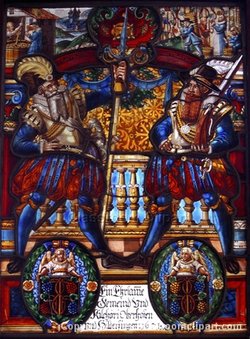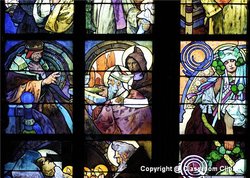Stained glass
|
|
 Stained glass photo provided by [http://classroomclipart.com Classroom Clip Art |
| ] |
Strictly speaking, stained glass is glass that has been painted with silver stain and then fired. Depending on its thickness, this stains clear glass with a gold/yellow/brown color. This appears most typically in the golden haloes depicted in church windows. In general usage, stained glass refers to glass that is colored by added metallic salts during its manufacture to create a wide variety of colors. Early stained glass artists were limited to a very few primary colors, but today almost any color can be produced.
These colored glasses are available in many different textures—smooth, wavy, rippled, hammered, pebbled, or very rough. These different textures cause the glass to have light and color transmission characteristics that, even for the same color, can provide surprising results.
In conventional stained glass work, glass of different colors is cut into pieces, shaped by grinding, and then assembled using zinc or lead cames or a copper foil method. The assembled pieces are then soldered together to create windows, panels, and/or lampshades incorporating colorful pictures and designs.
Stained glass is an art and a craft that requires the artistic skill to conceive of the design and the engineering skills necessary to assemble the piece so that it is capable of supporting its own weight and (for a window) surviving the elements.
After centuries of repetition and little innovation, stained glass underwent a major renaissance of form. The impetus for this new modern glass was the restoration of thousands of church windows throughout Europe, destroyed by World War II. German artists led the way, notable artists include Ludwig Shaffrath, Johannes Shreiter and many others who transformed an ancient art form into a contemporary art form.
Today there are few academic establishments that teach the traditional skillset. One of those establishments is Florida State University's Master Craftsman Program who recently completed the world's largest secular stained-glass windows installed at Doak Campbell Stadium's Bobby Bowden Field (http://craft.fsu.edu/featured_window.html). More info at Master Craftsman Program (http://www.craft.fsu.edu)
See also
- Arts and crafts
- Art glass
- Beveled glass
- Cathedral glass
- Float glass
- G. Owen Bonawit
- Glass mosaic
- Glassblowing
- Glass bead
- Hot glass
- Stained glass windows
- Churches - Stained glass windows are often used in more traditional church architectures, especially in the nave, to depict various saints and scenes from the Bible. This was especially important when the bulk of the population was illiterate. See also icon.
- Important examples of stained glass windows include Sainte-Chapelle, in Paris, France and Cathedral of Chartres, in Chartres, France
- Houses - Stained glass was particularly popular in the UK in the prosperous Victorian era and many domestic examples survive, typically depicting birds and flowers. Most of them rely on machine made patterned glass to refract the light rather than the more expensive hand-made glass used in church windows.
- Public houses - In Britain, traditional pubs make extensive use of stained glass and leaded lights to create a comfortable atmosphere and retain privacy.
- Churches - Stained glass windows are often used in more traditional church architectures, especially in the nave, to depict various saints and scenes from the Bible. This was especially important when the bulk of the population was illiterate. See also icon.
- Stained glass lamp / Lampshades
- Painted glass
- Tiffany glass
- Venetian glass

